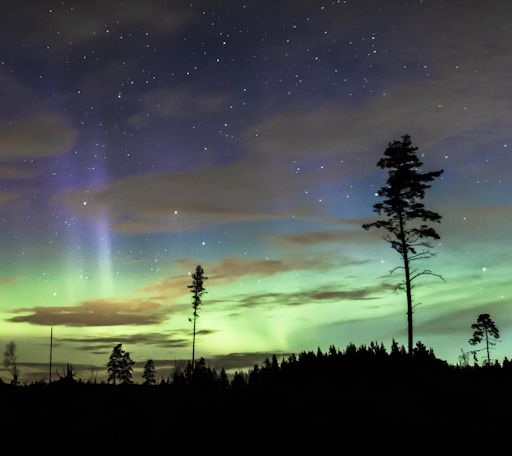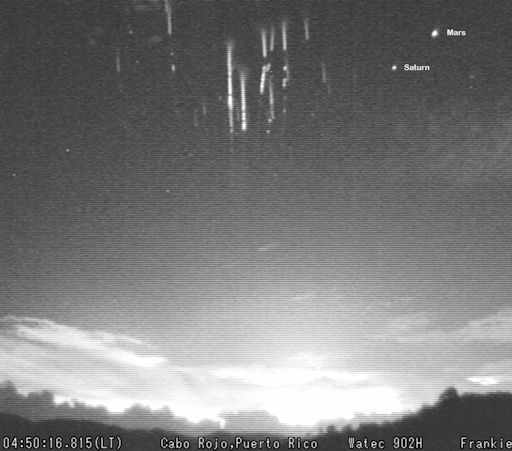On May 9th, the planet Mercury will pass in front of the sun, producing an inky-black spot on the solar disk. Catch it live on the Internet, courtesy of the Coca-Cola Space Science Center in Columbus, Georgia. | | | SPACE ROSES FOR MOTHER'S DAY: Nothing says "Happy Mother's Day" quite like a red rose from the edge of space. See? There's still time to buy a space rose for your own mom. Order one now from Earth to Sky Calculus for delivery before May 8th. All proceeds support student space weather research. NEGATIVE MAGNETIC FIELDS SPARK AURORAS: For the past three days Earth has been passing through a region of interplanetary space filled with negative-polarity magnetic fields. This has caused intermittent geomagnetic storms and beautiful auroras around both poles. On May 2nd, Svante Sandström photographed this display over Västerlanda, Sweden: 
"The auroras and their movements were absolutely stunning," says Sandström. "This could be the last performance of the season at our latitude," he adds. "Summer is coming, and the night skies are growing too bright for auroras." Earth entered this aurora-friendly region of space on Saturday, April 30th, when we crossed through a fold in the heliospheric current sheet. Many people have never heard of the heliospheric current sheet. It is one of the biggest things in the solar system--a vast undulating system of electrical currents shaped like the skirt of a ballerina: picture. Earth dips in and out of it all the time. Currently, we are on the side of the current sheet containing negative-polarity magnetic fields. Such fields can open a crack in our planet's magnetosphere, allowing solar wind to pour in and fuel colorful displays. During the current episode, Northern Lights have descended as far south as Michigan, while Southern Lights have ascended as far north as New Zealand. NOAA forecasters estimate a 25% chance of more storms tonight. Stay tuned. Aurora alerts: text or voice Realtime Aurora Photo Gallery "SPACE LIGHTNING" OVER THE CARRIBEAN: Sprite season is definitely underway. Only a few days after a widespread display appeared over Texas, more sprites have popped up near Puerto Rico. Frankie Lucena photographed them on May 1st from Cabo Rojo, PR: 
"They appeared right beside Mars and Saturn in the constellation Scorpius," says Lucena. "The sprites were over the Caribbean Sea just south of Cabo Rojo." Sprites are an exotic form of upper atmospheric electricity, sometimes called "space lightning" because they reach altitudes associated with meteors, noctilucent clouds and auroras. Some researchers believe they are linked to cosmic rays: Subatomic particles from deep space striking the top of Earth's atmosphere produce secondary electrons that, in turn, could provide the spark that triggers sprites. Lucena's ocean-going sprites are somewhat unusual. "A satellite study by Chen et al. 2008 (JGR) showed 49% of sprites to occur over land, 28% over the ocean and the remaining ones near the coastlines," explains lightning scientist Oscar van der Velde of the Technical University of Catalonia, Spain. "As oceans cover a greater area, this indicates sprites are more common over land-based storms." Although sprites have been seen for at least a century, most scientists did not believe they existed until after 1989 when sprites were photographed by cameras onboard the space shuttle. Now "sprite chasers" routinely photograph sprites from their own homes. "They are easily detected by certain cameras," says van der Velde, "and if a storm is in the mood, you may record one every few minutes." Give it a try! Realtime Sprite Photo Gallery
Realtime Space Weather Photo Gallery Realtime Comet Photo Gallery Every night, a network of NASA all-sky cameras scans the skies above the United States for meteoritic fireballs. Automated software maintained by NASA's Meteoroid Environment Office calculates their orbits, velocity, penetration depth in Earth's atmosphere and many other characteristics. Daily results are presented here on Spaceweather.com. On May. 2, 2016, the network reported 15 fireballs.
(12 sporadics, 3 eta Aquariids)  In this diagram of the inner solar system, all of the fireball orbits intersect at a single point--Earth. The orbits are color-coded by velocity, from slow (red) to fast (blue). [Larger image] [movies] Potentially Hazardous Asteroids ( PHAs) are space rocks larger than approximately 100m that can come closer to Earth than 0.05 AU. None of the known PHAs is on a collision course with our planet, although astronomers are finding new ones all the time. On May 2, 2016 there were potentially hazardous asteroids. Notes: LD means "Lunar Distance." 1 LD = 384,401 km, the distance between Earth and the Moon. 1 LD also equals 0.00256 AU. MAG is the visual magnitude of the asteroid on the date of closest approach. | | Cosmic Rays in the Atmosphere | | Situation Report -- Oct. 30, 2015 | Stratospheric Radiation (+37o N) | | Cosmic ray levels are elevated (+6.1% above the Space Age median). The trend is flat. Cosmic ray levels have increased +0% in the past month. | | Sept. 06: 4.14 uSv/hr (414 uRad/hr) | | Sept. 12: 4.09 uSv/hr (409 uRad/hr) | | Sept. 23: 4.12 uSv/hr (412 uRad/hr) | | Sept. 25: 4.16 uSv/hr (416 uRad/hr) | | Sept. 27: 4.13 uSv/hr (413 uRad/hr) | | Oct. 11: 4.02 uSv/hr (402 uRad/hr) | | Oct. 22: 4.11 uSv/hr (411 uRad/hr) | These measurements are based on regular space weather balloon flights: learn more. Approximately once a week, Spaceweather.com and the students of Earth to Sky Calculus fly "space weather balloons" to the stratosphere over California. These balloons are equipped with radiation sensors that detect cosmic rays, a surprisingly "down to Earth" form of space weather. Cosmic rays can seed clouds, trigger lightning, and penetrate commercial airplanes. Our measurements show that someone flying back and forth across the continental USA, just once, can absorb as much ionizing radiation as 2 to 5 dental X-rays. For example, here is the data from a flight on Oct. 22, 2015: 
Radiation levels peak at the entrance to the stratosphere in a broad region called the "Pfotzer Maximum." This peak is named after physicist George Pfotzer who discovered it using balloons and Geiger tubes in the 1930s. Radiation levels there are more than 80x sea level. Note that the bottom of the Pfotzer Maximim is near 55,000 ft. This means that some high-flying aircraft are not far from the zone of maximum radiation. Indeed, according to the Oct 22th measurements, a plane flying at 45,000 feet is exposed to 2.79 uSv/hr. At that rate, a passenger would absorb about one dental X-ray's worth of radiation in about 5 hours. The radiation sensors onboard our helium balloons detect X-rays and gamma-rays in the energy range 10 keV to 20 MeV. These energies span the range of medical X-ray machines and airport security scanners. | | The official U.S. government space weather bureau | | | The first place to look for information about sundogs, pillars, rainbows and related phenomena. | | | Researchers call it a "Hubble for the sun." SDO is the most advanced solar observatory ever. | | | 3D views of the sun from NASA's Solar and Terrestrial Relations Observatory | | | Realtime and archival images of the Sun from SOHO. | | | from the NOAA Space Environment Center | | | the underlying science of space weather | | 
